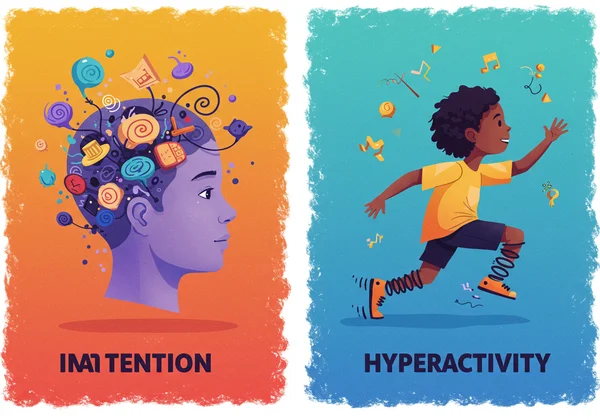Vanderbilt Assessment Scale: Your Guide to Understanding & Scoring
Feeling uncertain about your child's behaviors, especially related to focus, impulsivity, or hyperactivity? As a parent or educator, it's natural to seek clarity and support. The Vanderbilt Assessment is a trusted, evidence-based tool designed to help you do just that. What is the Vanderbilt Assessment? This comprehensive guide will walk you through its purpose, components, and scoring, empowering you with the knowledge to take the next confident step. For a hassle-free experience, you can start the assessment right away on our platform.

What is the NICHQ Vanderbilt Assessment Scale?
The NICHQ Vanderbilt Assessment Scale is more than just a questionnaire; it's a scientifically validated screening tool for Attention-Deficit/Hyperactivity Disorder (ADHD) in children aged 6 to 12. Developed by the National Institute for Children’s Health Quality (NICHQ) and endorsed by the American Academy of Pediatrics (AAP), it has become a gold standard for initial evaluations. Its primary purpose is to systematically gather insights into a child's behavior directly from parents and teachers—the people who know them best. This structured approach not only helps identify specific symptoms but also highlights performance issues that may require professional attention.
Instead of relying on guesswork, the scale provides a framework for observing and rating behaviors consistently. This data is invaluable for starting productive conversations with healthcare providers or school support staff.
A Brief History and Purpose of the Scale
The Vanderbilt Assessment Scale was created to provide a reliable method for pediatricians and clinicians to screen for ADHD. It addresses the core symptoms outlined in the Diagnostic and Statistical Manual of Mental Disorders (DSM). The goal was to create a tool that was not only accurate but also practical for busy parents and teachers to complete. It helps quantify observations about a child’s behavior, turning anecdotal concerns into structured data that can guide clinical judgment.
Parent vs. Teacher Forms: Key Differences
To get a complete picture of a child's behavior, the Vanderbilt Assessment includes two separate but parallel forms: one for parents and one for teachers. This is a critical feature, as a child may behave differently at home than in a structured classroom setting.
- Vanderbilt Assessment Parent Form: This form asks parents or guardians to rate their child's behavior in the home and social environment. It provides insight into family dynamics, peer interactions, and how the child functions during daily routines.
- Vanderbilt Assessment Teacher Form: This form is completed by a teacher who has had significant interaction with the child. It focuses on academic performance, classroom behavior, and interactions with classmates.
Comparing the results from both the parent and teacher rating scales gives a comprehensive, 360-degree view of the child's challenges and strengths. Our platform makes it easy to complete the parent form or send a secure link to a teacher.

Decoding the Vanderbilt ADHD Assessment Scale's Components
The power of the Vanderbilt ADHD Assessment lies in its thoroughness. It doesn't just ask "Is my child hyperactive?" Instead, it breaks down complex behaviors into distinct categories, providing a more nuanced understanding. This approach helps to screen not only for ADHD but also for other conditions that often co-occur with it.
Primary Symptom Domains: Inattention & Hyperactivity-Impulsivity
This is the core of the ADHD screening. The questions in this section are directly aligned with the DSM criteria for ADHD and are divided into two key areas:
-
Inattention: These questions explore difficulties with sustaining focus, making careless mistakes, losing things, being easily distracted, or forgetting daily tasks.
-
Hyperactivity-Impulsivity: This section assesses symptoms like fidgeting, being unable to stay seated, running or climbing excessively, talking too much, interrupting others, and having difficulty waiting for one's turn.

Screening for Co-occurring Behavioral Conditions (ODD, CD)
Children with ADHD often face challenges in other behavioral areas. The Vanderbilt scale wisely includes sections to screen for common co-occurring conditions, providing a more complete picture of a child's emotional and behavioral health. These include:
- Oppositional Defiant Disorder (ODD): Assesses patterns of angry or irritable mood, argumentative or defiant behavior, and vindictiveness.
- Conduct Disorder (CD): Looks for more severe patterns of behavior that violate the rights of others or major societal norms, such as aggression, destruction of property, or deceitfulness.
Identifying Internalizing Symptoms: Anxiety and Depression
Behavioral challenges aren't always external. The scale also includes questions to screen for internalizing problems, which can sometimes be mistaken for or overlap with ADHD symptoms. This section helps identify potential signs of:
- Anxiety: Feelings of fear, worry, or nervousness that are persistent and overwhelming.
- Depression: Symptoms of sadness, loss of interest, irritability, or feelings of worthlessness.
Identifying these internal struggles is a crucial step in comprehensively assessing a child's overall well-being.
Your Comprehensive Vanderbilt Assessment Scoring Guide
Manually scoring the Vanderbilt Assessment can seem daunting, which is why using an online Vanderbilt assessment that automates the process is highly recommended. However, understanding the scoring logic is empowering. It helps you grasp what the final numbers actually mean before you discuss them with a professional.
Step-by-Step Scoring for Both Parent and Teacher Forms
The scoring process involves a few key steps. Each behavioral question is rated on a 4-point scale: 0 (Never), 1 (Occasionally), 2 (Often), and 3 (Very Often).
-
Symptom Count: For the main ADHD sections (Inattention and Hyperactivity/Impulsivity), you count the number of questions marked with a 2 or 3. These scores indicate clinically significant symptoms.
-
Thresholds: To meet the criteria for a positive screen for ADHD, a certain number of symptoms must be marked as "Often" or "Very Often." For example, for the inattentive subtype, a child typically needs to have 6 or more scores of 2 or 3 out of the 9 inattention questions.
-
Co-occurring Conditions: The ODD, CD, and Anxiety/Depression sections are scored similarly, by counting the number of items rated as 2 or 3 and comparing them to a specific threshold for that condition.
-
Performance Section: The final section assesses the child's performance in school and relationships, rated on a scale from "Excellent" to "Problematic." Scores in the "Problematic" range (4 or 5) are significant indicators of impairment.

Interpreting Raw Scores and Severity Levels
A "high score" on the Vanderbilt assessment means the child has a significant number of reported symptoms in a particular area. It doesn't provide a diagnosis, but it does signal that the child's behaviors are frequent and severe enough to warrant a formal evaluation by a qualified professional, like a pediatrician, psychologist, or psychiatrist. The number of symptoms and the impairment score together help determine the potential severity.
Important Considerations for Interpretation (Screening, Not Diagnosis)
This is the most critical takeaway: the Vanderbilt Assessment is a screening tool, not a diagnostic instrument. A positive screen does not automatically mean a child has ADHD or any other disorder. It simply indicates that there are enough concerns to justify a follow-up conversation and comprehensive evaluation with a healthcare professional. They will use the results from the scale, along with clinical interviews, direct observation, and other information, to make an accurate diagnosis. The ADHD screening tool is your first step, not the final word.
Gaining Clarity with the Vanderbilt Assessment Scale
Feeling overwhelmed by concerns about your child's development is natural, but you don't have to navigate it alone. The Vanderbilt Assessment Scale offers a reliable, structured starting point, transforming vague worries into clear, actionable insights that highlight your child's unique strengths and challenges. By decoding its components and scoring, you are better prepared to advocate for your child and collaborate effectively with professionals.
Ready to gain that clarity? Skip the confusion of manual paperwork and scoring. Use our confidential, easy-to-use online vanderbilt test to get instant, automated results. It’s the first step toward understanding and support.
Frequently Asked Questions About the Vanderbilt Assessment
What is the Vanderbilt Assessment?
The Vanderbilt Assessment is a highly respected screening questionnaire used by parents and teachers to identify symptoms of ADHD and other co-occurring behavioral and emotional conditions in children aged 6-12. It helps structure observations to facilitate discussion with healthcare providers.
How to score the Vanderbilt Assessment?
Scoring involves counting the number of items rated as "Often" or "Very Often" (a score of 2 or 3) within specific symptom categories. These totals are then compared against established thresholds. To simplify this, our free online tool provides instant and accurate scoring automatically.
Is the Vanderbilt ADHD assessment accurate?
Yes, when used as a screening tool, the Vanderbilt Assessment is considered a reliable and valid instrument. Its accuracy is highest when information is gathered from both parents and teachers. However, it is not a substitute for a comprehensive diagnostic evaluation by a qualified professional.
Where can I find the Vanderbilt parent/teacher form?
You can find convenient, easy-to-use digital versions of both the Vanderbilt parent and teacher forms right here. Our platform allows you to complete the questionnaire online and receive a confidential report immediately. Try our free tool to get started.
What does a high score on the Vanderbilt assessment mean?
A high score indicates that a significant number of symptoms for a particular condition (like ADHD, ODD, or anxiety) were reported as occurring frequently. It serves as a strong signal that a follow-up evaluation with a pediatrician or child psychologist is recommended to determine if a diagnosis is appropriate and discuss next steps.